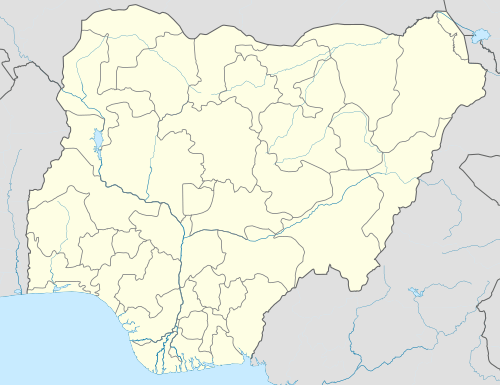Ilorin Emirate
The Ilorin Emirate is a traditional state based in the city of Ilorin in Kwara State, Nigeria. It is a prominent city largely populated by the Yoruba speaking people group of West Africa. It is considered by some to be one of the Banza Bakwai, or copy-cats of the Hausa Kingdoms.
Ilorin Emirate | |
|---|---|
Traditional state | |
 Ilorin Emirate Location in Nigeria | |
| Coordinates: 8°30′N 4°33′E | |
| Country | |
| State | Kwara State |
| Government | |
| • Emir | Ibrahim Kolapo Sulu Gambari |
History
At the start of the 19th century Ilorin was a border town in the northeast of the Oyo Empire, with a mainly Yoruba population but with many Hausa and Fulani immigrants. It was the headquarters of an Oyo General, Afonja, who rebelled against the empire and helped bring about its collapse with the assistance of the Fulani.[1] The rebellion was powered by Nupe and Bornu Moslem slaves.[2] Afonja had been assisted by Salih Janta, also called Shehu Alimi, a leader of the local Fulani. In 1824, Afonja was assassinated and Salih's son Abdulsalam became Emir.[3] Ilorin became an emirate of the Sokoto Caliphate.[1]
For some time, Ilorin was a major center of the slave trade. In the past, slaves had mainly been sent north across the Sahara, but now they were being sent south via the Yoruba lands to the coast to supply demand from the USA, the West Indies, and Brazil. Slaves were taken from the Igbo lands to the east and from conquered Yoruba towns, as well as from areas further to the north, and were traded for cloth and other goods.
Ilorin continued to expand southward until it was checked in the 1830s by the growing power of Ibadan, an Oyo successor state. The Ilorin cavalry were ineffective in the jungle to the south, and by the 1850s Ibadan had access to guns from European traders on the coast.[1] The capital was occupied by the Royal Niger Company in 1897 and its lands incorporated into the British colony of Northern Nigeria in 1900, although the emirate continued to perform ceremonial functions.[4]
Rulers
Rulers of the Ilorin Emirate:[5]
| Start | End | Ruler |
|---|---|---|
| 1824 | 1842 | Abdusalami dan Salih Alimi |
| 1842 | 1860 | Shita dan Salih Alimi |
| 1860 | 1868 | Zubayro dan Abdusalami |
| 1868 | 1891 | Shita Aliyu dan Shittu |
| 1891 | 1896 | Moma dan Zubayru |
| 1896 | 14 January 1914 | Sulaymanu dan Aliyu |
| 1915 | November 1919 | Shuaybu Bawa dan Zubayru |
| 17 February 1920 | June 1959 | Abdulkadir dan Shuaybu Bawa |
| 30 June 1959 | 1992 | Zulkarnayni Gambari dan Muhammadu Laofe Dan Bawa "Aiyelabowo V" |
| 1992 | August 1995[6] | Malam Aliyu dan Abdulkadir |
| 1995 | Till Date | Ibrahim Sulu-Gambari |
Kingmakers and sub-chiefs of Ilorin
Due to Ilorin's unique history, first as a Yoruba outpost of the Oyo Empire, then as a Fulani vassal of the Sokoto Caliphate, it has a kingmaking tradition that is a blend of traditions taken from both sources. Whenever the throne of the emirate (which is vested in the Fulani descendants of Shehu Alimi) is vacant, the representative of each quarter in the Emirate namely; the Balogun Gambari (Hausa), the Balogun Ajikobi (Yoruba), the Balogun Fulani (Fulani) and the Balogun Alanamu (Yoruba) - along with the head of the Afonja chieftaincy family, the Mogaji Aare, and his sub-chief called the Baba Isale of Ilorin - come together to elect and install a new emir, subject to the approval of the governor of Kwara State. The longest reigning of the four Baloguns is conferred with the Balogun Agba title, which makes him the second in command to the Emir of Ilorin. All of the Baloguns have districts which they administer on the emir's behalf.
There are also traditional chiefs that are each known as Daudu (or District Head). They serve as lieutenants representing the emir in towns across the Ilorin Emirate such as Afon, Bode Saadu, Ipaye and Malete, among others.
References
- Paul E. Lovejoy (2004). Slavery on the frontiers of Islam. Markus Wiener Publishers. p. 55ff. ISBN 1-55876-329-5. Retrieved 30 September 2010.
- Rex Seán O'Fahey (1995). Arabic literature of Africa: the writings of the Muslim peoples of Northeastern Africa, Volume 3. BRILL. p. 440. ISBN 90-04-10494-1. Retrieved 30 September 2010.
- "Ilorin". Encyclopædia Britannica. Retrieved 30 September 2010.
- Chisholm, Hugh, ed. (1911). . Encyclopædia Britannica. 14 (11th ed.). Cambridge University Press. p. 312.
- "Traditional States of Nigeria". WorldStatesmen.org. Retrieved 30 September 2010.
- editor (4 June 2019). "Tribute: Her Royal Majesty, Aishat Nma Sulu-Gambari finally takes a bow". Royal News. Retrieved 13 June 2019.CS1 maint: extra text: authors list (link)